Insignia ranks of the Russian Army. XIX-XX century
(1854-1917)
Officers and generals
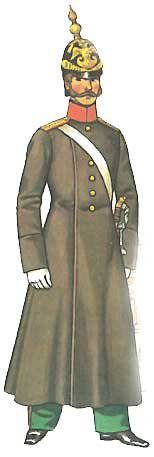 The appearance of galunny epaulettes with insignia of ranks on the uniform of officers and generals of the Russian Army is associated with the introduction of soldier-style hiking coats for 29 on April 1854 (the only difference was that there were side slit pockets with flaps on the officer's overcoat).
The appearance of galunny epaulettes with insignia of ranks on the uniform of officers and generals of the Russian Army is associated with the introduction of soldier-style hiking coats for 29 on April 1854 (the only difference was that there were side slit pockets with flaps on the officer's overcoat).In the picture to the left: an officer’s military overcoat of the 1854 model of the year.
This overcoat was introduced only for wartime and existed just over a year.
At the same time, the same Command for this overcoat introduces galloon shoulder straps (Order of the Military Department No. XXUMX 53)
From the author. Until that time, the so-called "Nikolaev overcoat", on which no insignia at all was put, was the only authorized pattern of the outerwear of the officers and generals.
Studying numerous paintings, drawings of the XIX century, you come to the conclusion that the Nikolaev overcoat was not suitable for war, and few people wore it in traveling conditions.
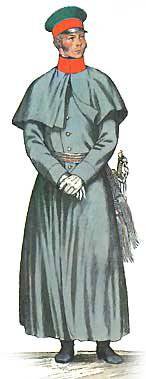 Apparently, as a marching overcoat, officers more often used a frock coat with epaulets. In general, the coat was intended for everyday wear outside the building, and not as outerwear for winter.
Apparently, as a marching overcoat, officers more often used a frock coat with epaulets. In general, the coat was intended for everyday wear outside the building, and not as outerwear for winter.But in the books of that time there are often references to warm-lined frock coats, wool-padded frock coats and even frock fur coats. Such a warm frock coat was also quite suitable as a replacement for a Nikolaev overcoat.
However, the same expensive cloth was used for coats as for uniforms. And by the middle of the XIX century, the army became more and more mass, which entails not just an increase in the number of officers' corps, but also an increasing involvement in the officer corps of people who have no income, except for the officer’s salary, which was very scarce at that time. There is a need to reduce the cost of military uniforms. This was partially resolved by the introduction of officers' camp uniforms from coarse but durable and warm soldier's cloth, and the replacement of very expensive epaulettes with relatively cheap galloon shoulder straps.
By the way, the "Nikolaev" this characteristic type of overcoat with a cape, and often with a furs collar, is generally called a mistake. She appeared in the era of Alexander I.
The figure on the right is an officer of the Butyrsky Infantry Regiment 1812 of the year.
Obviously she began to be called Nikolaev after the appearance of a marching overcoat with epaulets. Probably, wanting to emphasize the backwardness in the military affairs of one or another general, they used to say in the last quarter of the XIX century: "Well, he still wears the Nikolaev overcoat." However, this is more my speculation.
Actually, in the 1910 year, this Nikolaev overcoat with fur lining and fur collar was preserved as outerwear outside the building along with the coat (in fact, this is also an overcoat, but in a different cut than the marching 1854). Although the Nikolaev overcoat is rarely worn.
Initially, and I ask you to pay special attention to this, officers and generals had to wear epaulets of soldiers (pentagonal shape), the colors assigned to the regiment, but the width of the 1 1 / 2 top (67mm.). And on this epaulet of the soldier’s sample galloons are sewn.
Let me remind you that the soldier's epaulet in those days was soft, the width of the 1.25 top (56mm.). Long on the shoulder (from the shoulder seam to the collar).
Shoulder straps 1854 of the year
1854 Generals
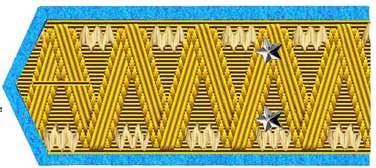 For epaulettes width 1.5 the top (67mm.) For the designation of the generals' rank was sewn a galloon width 2 inch (51 mm). Thus, the 8 mm shoulder strap was left open. from the side and top edges. Type of galun - "... from the galun, assigned to the collars of the general hussars of the Hungarians ...".
For epaulettes width 1.5 the top (67mm.) For the designation of the generals' rank was sewn a galloon width 2 inch (51 mm). Thus, the 8 mm shoulder strap was left open. from the side and top edges. Type of galun - "... from the galun, assigned to the collars of the general hussars of the Hungarians ...".It should be noted that the later drawing of the General's galun on epaulets will noticeably change, although the general character of the pattern will remain ..
The color of galun according to the color of the metal of the regiment, i.e. gold or silver. Asterisks indicating a rank of the opposite color, i.e. On a silver galloon gold, on gold silver. Metal forged. The diameter of the circle in which the asterisk 1 / 4 top (11 mm.).
Number of stars:
* 2 - Major General.
* 3 - Lieutenant General.
* without asterisks - general (from infantry, from cavalry, feldtsekhmeister general, engineer-general).
* crossed wands - Field Marshal General.
From the author. People often ask why the Major General on uniform and epaulettes had not one, but two asterisks. I believe that the number of stars in Tsarist Russia was not determined by the name of the rank, but by its class according to the Table of Ranks. Five classes were assigned to the ranks of the generals (from V to I). From here - the fifth class - 1 asterisk, the fourth class - 2 asterisks, the third class - 3 asterisks, the second class - without asterisks, the first class - the crossed batons. In the civil service to the 1827, year V class existed (State Councilor), and in the army of this class was not. Following the rank of colonel (class VI) immediately went the rank of major general (class IV). Therefore, the Major General is not one, but two asterisks.
By the way, when in 1943 new insignia (shoulder straps and stars) were introduced into the Red Army, the major general was given one star, thus leaving no room for a possible return to the rank of brigade commander (brigadier general or something like that). Although even then there was a need for that. Indeed, in tank corps of 43 were not tank divisions, but tank brigades. There were no tank divisions. There were also separate rifle brigades, marine brigades, and airborne brigades.
True, after the war completely switched to the divisions. Brigades as military units, in general, have disappeared from the nomenclature of the formations of our army with very few exceptions, and the need for an intermediate rank between a colonel and a major general seems to have disappeared.
But now, when the army switches over to the brigade system in general, the need for a rank between a colonel (regiment commander) and a major general (division commander) is greater than ever. For the commander of the brigade the rank of colonel is not enough, and the rank of Major General is a bit too much. And if you enter the title of brigadier general, what are he to give signs of distinction? General's epaulette without stars? But today it will look ridiculous.
1854 Headquarters Officers
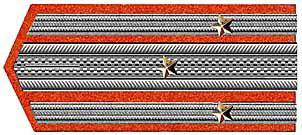 On the epaulet, to designate the staff officers, three bands were stitched along the epaulette from galun, assigned to cavalry shoulder strap, sewn (several distance from the edges of the epaulette in three rows, with two openings in the 1 / 8 vertex ".
On the epaulet, to designate the staff officers, three bands were stitched along the epaulette from galun, assigned to cavalry shoulder strap, sewn (several distance from the edges of the epaulette in three rows, with two openings in the 1 / 8 vertex ".However, this lace has a width of 1.025 inches (26 mm.). The width of the lumen 1 / 8 top (5.6mm.). Thus, if you follow the “Historical Description”, the width of the headquarters officer’s shoulder should have been 2 in 26mm. + 2 in 5.6mm, and the total 89mm.
And at the same time, in the illustrations for this edition, we see the headquarters officer uniform the same width as the general’s, i.e. 67mm. In the middle there is a purl braid 26mm wide, and to the left and right of it, backing up to 5.5 - 5.6 mm. two narrow galloons (11mm.) of a special pattern, which later in the Description of officers' uniforms of the 1861 edition of the year will be described as ... "in the middle oblique stripes, and along the edges of small towns". Later this type of galuna will be called the "headquarters officer galun".
Remain free edge epaulet on 3.9-4.1mm.
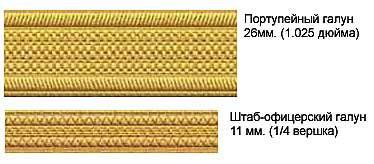 Here I specifically show the enlarged types, galloons, which were used on the shoulder straps of the staff officers of the Russian Army.
Here I specifically show the enlarged types, galloons, which were used on the shoulder straps of the staff officers of the Russian Army.From the author. I ask you to pay attention to the fact that with the external similarity of the pattern of the galloon, the Russian Army is up to 1917. and the Red (Soviet) Army with 1943g. still differ considerably. On this, and caught the person embroidering on the Soviet officer's shoulder straps of the monogram of Nicholas II and selling them under the guise of genuine royal shoulder straps, which are now a big fashion. If the seller honestly says that this is a replica, then he can only be blamed for mistakes, but if he says foaming at the mouth that this is his great-grandfather's chase, which he personally found in the attic, it’s better not to do business with such a person.
The color of galun according to the color of the metal of the regiment, i.e. gold or silver. Asterisks indicating the rank of the opposite color, i.e. On a silver galloon gold, on gold silver. Metal forged. The diameter of the circle in which the asterisk 1 / 4 top (11 mm.).
Number of stars:
* Major - 2 asterisks,
* Lieutenant Colonel - 3 asterisks,
* Colonel- no stars.
From the author. And again, they often ask why the major has not one (as it is now), but two asterisks on shoulder straps. In general, it is difficult to explain, especially since if you go from the very bottom, then everything goes as far as a major. The youngest officer warrant officer has an 1 asterisk, then the 2, 3 and 4 asterisks. And the most senior ober-officer's rank - the captain, has shoulder straps without stars.
It would be correct for the youngest of the staff officers to give one star too. But they gave two.
Personally, I find this only one explanation (although not particularly convincing) - before 1798, there were two ranks in the VIII class in the army - the major major and the major major.
But by the time of the introduction of stars on the epaulettes (in 1827 year), the Major’s rank remained only one. Obviously, in memory of the two Majors of the past, the major was given not one, but two asterisks. It is possible that one star was reserved. At that time, there were still debates whether it would be advisable to have only one Major rank.
Chief officers 1854
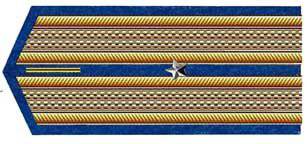 On the epaulet, to designate the senior officers, two bands of the same galun were sewn along the epaulettes as the middle galun (26mm.) On the headquarters officer chase. The gap between the galloons is also the 1.8 vertex (5.6 mm.).
On the epaulet, to designate the senior officers, two bands of the same galun were sewn along the epaulettes as the middle galun (26mm.) On the headquarters officer chase. The gap between the galloons is also the 1.8 vertex (5.6 mm.).The color of galun according to the color of the metal of the regiment, i.e. gold or silver. Asterisks indicating the rank of the opposite color, i.e. On a silver galloon gold, on gold silver. Metal forged. The diameter of the circle in which the asterisk 1 / 4 top (11 mm.).
Number of stars:
* Ensign - 1 asterisk,
* second lieutenant - 2 asterisks,
* Lieutenant - 3 stars,
* staff captain - 4 asterisks,
* captain without stars.
Shoulder straps 1855 of the year
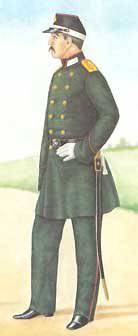 The first experience of wearing shoulder straps turned out to be successful, and their practicality turned out to be undoubted. And on March 12, Emperor Alexander II, who came to the throne, ordered 1855 to replace the epaulettes with epaulets on newly introduced Vic semi-caftans for everyday wear.
The first experience of wearing shoulder straps turned out to be successful, and their practicality turned out to be undoubted. And on March 12, Emperor Alexander II, who came to the throne, ordered 1855 to replace the epaulettes with epaulets on newly introduced Vic semi-caftans for everyday wear.So gradually begin to leave the officer epaulettes. By 1883, they will remain only in full dress.
20 May 1855. Soldier’s sample military outfit is replaced with a double-breasted cloth coat (cloak). True, in everyday life, they also began to call him a greatcoat. In all cases, only epaulets are worn on a new coat. Stars on shoulder straps are ordered to be embroidered with silver thread on golden shoulder straps and gold thread on silver shoulder straps.
From the author. From this time until the end of the existence of the Russian Army, the stars on the epaulets should have been forged metal, and embroidered on epaulets. In any case, in the Rules for wearing uniforms by officers of the 1910 edition, this provision was maintained.
However, how rigorously the officers followed these rules is difficult to say. The discipline of military uniform in those days was significantly lower than in Soviet times.
In November 1855, the type of epaulettes changes. By order of the Minister of War from November 30 1855. Liberties in the width of the epaulet, so ordinary before, is now not allowed. Strictly 67 mm. (1 1 / 2 top). The shoulder strap is sewn into the shoulder seam with the lower edge, and the upper one is fastened to a button with a diameter of 19mm. The color of the button is the same as the color of the galloon. The upper edge of the shoulder strap is cut off like on epaulets. From this time on, the officer’s shoulder straps differ from the soldiers in that they are hexagonal and not pentagonal.
At the same time, the shoulder straps themselves remain soft.
1855 Generals
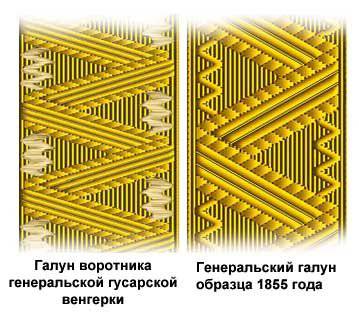
The galun of the general's uniform has changed in design and in width. The old lace had an 2 inch width (51 mm), the new one got the width of the 1 1 / 4 tip (56 mm). Thus, the shoulder strap field protruded beyond the edges of the galun on the 1 / 8 top (5,6 mm).
The figure to the left shows a galun worn by generals on epaulets from May 1854 to November 1855, to the right, which was kept in 1855 and which has survived to this day.
From the author. Please pay attention to the width and frequency of large zigzags, as well as to the drawing of small zigzags between large ones. At first glance, this is imperceptible, but in fact it is very significant and can help uniformatist lovers and reenactors of military uniforms avoid mistakes and distinguish low-quality replicas from genuine products of those times. And sometimes it can help date a photograph, a picture.
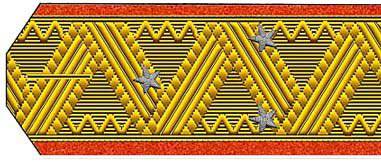
The upper end of the galloon is now bent over the upper edge of the shoulder strap. The number of stars on the uniform by rank remains unchanged.
It should be noted that the place of the stars on the epaulets and the generals and officers was not determined strictly according to the place, as now. They had to be located on the sides of the encryption (the number of the regiment or the monogram of the highest chief), the third above. So that the asterisks make up the ends of an equilateral triangle. If this was not possible due to the size of the encryption, then the asterisks were placed above the encryption.
1855 Headquarters Officers
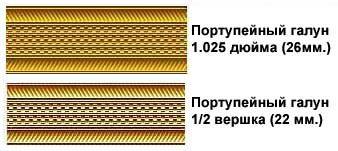 As with the generals, galloons on the headquarters for officers were bending around the upper edge. The average lace (purplish) received a width not of an 1.025 inch (26mm), as on the epaulettes of the 1854 model of the year, but an 1 / 2 inch (22 mm.) Gaps between the middle and side trunks of the 1 / 8 tip (5,6 mm). Side galloons as before, the width of the 1 / 4 top (11 mm).
As with the generals, galloons on the headquarters for officers were bending around the upper edge. The average lace (purplish) received a width not of an 1.025 inch (26mm), as on the epaulettes of the 1854 model of the year, but an 1 / 2 inch (22 mm.) Gaps between the middle and side trunks of the 1 / 8 tip (5,6 mm). Side galloons as before, the width of the 1 / 4 top (11 mm). Asterisks sewn color reverse color of the galloon diameter 11 mm. Those. on a gold lace, stars are embroidered with a silver thread, and on a silver lace, a gold thread.
Note. With 1814, the colors of the epaulets of the lower ranks, and of course with 1854 and the officers' epaulets were determined by the rank of the regiment in the division. So in the first regiment of the division, the shoulder straps are red, in the second - white, in the third - light blue. For the fourth regiments, the shoulder straps are dark green with red piping. In the grenadier shelves epaulets yellow. All the artillery and engineer troops epaulettes are red. It is in the army.
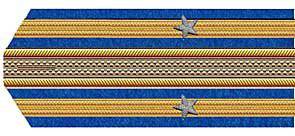 In the guard epaulets in all the shelves are red.
In the guard epaulets in all the shelves are red.The cavalry units had their own peculiar color patterns.
In addition, there were numerous deviations in the colors of epaulets from the general rules that were dictated by the historically accepted colors for this regiment, then the wishes of the emperor. And these rules themselves were not established once and for all. They periodically changed.
It should also be noted that all the generals, as well as the officers serving in non-regiments, were assigned to certain regiments and, accordingly, wore regimental-colored shoulder straps.
Chief officers 1855
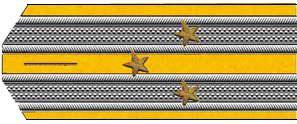 On the ober-officer's uniform, two 1 / 2 width bolster tails were sewn (22 mm.) They retreated from the edges of the shoulder strap, as on the previous ones, on the 1 / 8 top (5.6 mm.), And had a clearance between them in 1 / 4 vertex (xnumx mm).
On the ober-officer's uniform, two 1 / 2 width bolster tails were sewn (22 mm.) They retreated from the edges of the shoulder strap, as on the previous ones, on the 1 / 8 top (5.6 mm.), And had a clearance between them in 1 / 4 vertex (xnumx mm).From the author. Please note that the clearance on epaulets of senior officers in 1855 is very wide. Twice as wide as the staff officers.
Asterisks sewn color reverse color of the galloon diameter 11 mm. Those. on a gold lace, stars are embroidered with a silver thread, and on a silver lace, a gold thread.
The shoulder straps, shown above for clarity, are shown only with insignia. However, it should be remembered that in the times described the epaulets had a double function — the external qualifier of ranks and the determinant of the belonging of a serviceman to a certain regiment. The second function was to some extent carried out by the colors of the epaulettes, but to the full extent by attaching monograms, numbers and letters indicating the number of the regiment on the shoulder straps.
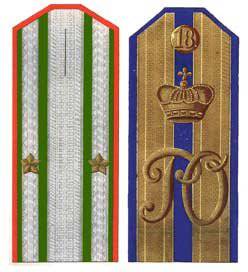 Monograms were also placed on shoulder straps. The system of monograms is so complex that a separate article is required. For now we will restrict ourselves to brief information.
Monograms were also placed on shoulder straps. The system of monograms is so complex that a separate article is required. For now we will restrict ourselves to brief information.On the epaulettes monograms and encryption, the same as on epaulettes. The stars were sewn on triangles in the shape of a triangle and positioned as follows - two lower stars on both sides of the encryption (or, if there is no space above it), and on epaulets without encryption - at a distance 7 / 8 top (38.9mm.) From their lower edge . The height of the letters and numbers of the encryption was generally equal to the 1 tip (4.4 see).
On epaulettes, with the vypushku galun in the upper edge of the epaulet reached only vypushka.
However, by the year 1860 and on shoulder straps that did not have any edging, they also began to cut the galunet, not reaching the upper edge of the shoulder strap by approximately the 1 / 16 top (2.8mm.)
The figure shows the epaulettes of the Major of the Fourth Regiment on the left in the division on the left, and the captain of the Third Regiment in the division on the right (on the pursuit of the monogram of the highest regiment of Prince Oransky).
Since the shoulder strap was sewn into the shoulder seam, it was impossible to remove it from the uniform (caftan, Vic semi-caftan). Therefore, epaulettes in cases where they should be worn, fastened directly over the epaulet.
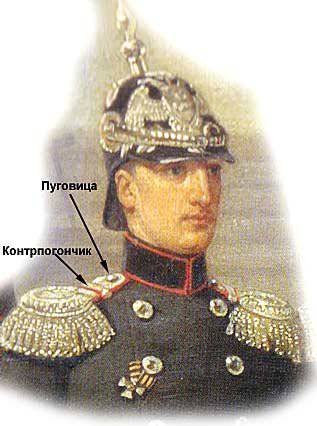 The peculiarity of the mounting of the epaulet was that it lay on the shoulder completely free. Only the upper end was fastened to the button. From shifting forward or backward, he was held back by a so-called. kontropogonchik (also called kontrépolelet, a driver), which was a loop of narrow galloon sewn on the shoulder. Epaulet slipped under kontrpogonchik.
The peculiarity of the mounting of the epaulet was that it lay on the shoulder completely free. Only the upper end was fastened to the button. From shifting forward or backward, he was held back by a so-called. kontropogonchik (also called kontrépolelet, a driver), which was a loop of narrow galloon sewn on the shoulder. Epaulet slipped under kontrpogonchik.When wearing a shoulder strap, the counterhamer lay under the shoulder strap. In order to put on an epaulette, the epaulettes were unfastened, passed under the counterhunter and re-fastened. Then, under the counter raiser, an epaulet was let through, which was also fastened to a button.
However, such a “sandwich” looked very unfortunate, and 12 March 1859 of the year was followed by the Order, which allowed to remove epaulettes when it is necessary to wear epaulets. This led to a change in the design of epaulets.
Basically, the way in which the epaulet was attached at the expense of a strap sewn to the lower edge of the epaulet from the wrong side got accustomed. This strap passed under the counterhunter, and its upper end was fastened to the same button as the shoulder strap itself.
This mounting was in many ways similar to the mounting of the epaulet, with the only difference being that it was not a shoulder strap that passed under the counterguard, but its strap.
In the future, this method will remain almost the only (except for the complete sewing of shoulder strap). Sewing the bottom edge of the shoulder strap into the shoulder seam will remain only on the coat (overcoats), since the wearing of epaulettes on them was not originally intended.
On uniforms, which were used as ceremonial and ordinary, i.e. worn with epaulets and with epaulets, this counterferee was also preserved at the beginning of the 20th century. On all other forms of the form, instead of a counter raid, a belt loop was used unnoticeable under the shoulder strap.
1861 year
This year comes the "Description of the officer's uniform" which states:
1. The width of the shoulder strap for all officers and generals 1 1 / 2 top (67mm.).
2. The width of the gaps on the head and the head officer epaulets 1 / 4 top (5.6mm.).
3. The distance between the edge of the galun and the edge of the epaulette 1 / 4 top (5.6mm.).
However, using the standard portcloth of that time: (narrow 1 / 2 top (22mm) or wide 5 / 8 top (27.8mm.)) It is impossible to achieve regulated clearances and edges with a regulated shoulder width. Therefore, manufacturers of epaulettes either went to a certain change in the width of the galloons, or to a change in the width of the epaulet.
This position remained until the end of the existence of the Russian Army.
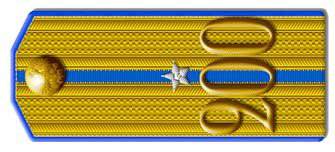 From the author. On the wonderfully executed Alexey Khudyakov (may he forgive me for such a shameless borrowing) of the epaulette pattern of warrant officer of the 200 th Kronshlot Infantry Regiment, one can clearly see the pattern of a wide tailgun. It is also clearly noticeable that the free side edges of the shoulder strap are narrower than the width of the lumen, although according to the rules they should be equal.
From the author. On the wonderfully executed Alexey Khudyakov (may he forgive me for such a shameless borrowing) of the epaulette pattern of warrant officer of the 200 th Kronshlot Infantry Regiment, one can clearly see the pattern of a wide tailgun. It is also clearly noticeable that the free side edges of the shoulder strap are narrower than the width of the lumen, although according to the rules they should be equal.An asterisk (silver embroidered) is placed above the encryption. Accordingly, the stars of the second lieutenant, the lieutenant and the staff captain will be located above the encryption, and not on the sides of it, since there is no place for them because of the three-digit number of the regiment.
Sergey Popov, in an article in the magazine “Old Zeughgauz”, writes that in the sixties of the 19th century, private production of gallops for headquarters and ober-officers' shoulder straps, which were a whole braid in one or two color bands of the prescribed width (5.6m), was spread . And the width of such solid galloon was equal to the width of the general's galloon (1 1 / 4 top (56 mm)). This is probably true (numerous photographs of the surviving epaulets confirm this), although even during the Great War there were epaulettes made according to the rules (Rules for wearing clothing by officers of all types of arms. S.-Petersburg. 1910).
Obviously, both types of epaulets were in use.
From the author. This is how the understanding of the term "gaps" began to disappear. Initially, it really was a gap between the rows of galloons. Well, when it became just colored stripes in a galloon, their early understanding was lost, although the term itself was preserved even in Soviet times.
The circulars of the General Staff No.23 1880 of the year and No.132 1881 of the year were allowed to wear metal plates on the shoulder straps instead of a galloon, on which a galunny pattern was stamped.
Significant changes in the size of epaulets and their elements in subsequent years did not occur. Is that in 1884, the rank of major was abolished and the staff officer shoulder straps with two asterisks went to history. From this time on, there were either no stars at all (colonel), or there were three (lieutenant colonel). Note that in the rank of guard the lieutenant colonel did not exist.
It should also be noted that since the appearance of the officer's galloon shoulder straps, besides ciphers, asterisks in special births weapons (artillery, engineering troops) on shoulder straps housed the so-called. special signs indicating that the officer belongs to a special type of weapon. For the gunners, they were the crossed trunks of old cannons, for the sapper battalions, the crossed ax and shovel. As the special forces developed, the number of special signs (now they are called emblems of the armed forces) and by the middle of the Great War there were more than two dozen of them. Not having the opportunity to show them all, we limit ourselves to the available author. The color of special signs with some exceptions coincided with the color of the galun. They were usually made of brass. For a silver field of epaulettes, they were usually frosted or silvered.
By the time of the outbreak of the First World War, the officer's shoulder straps were as follows:
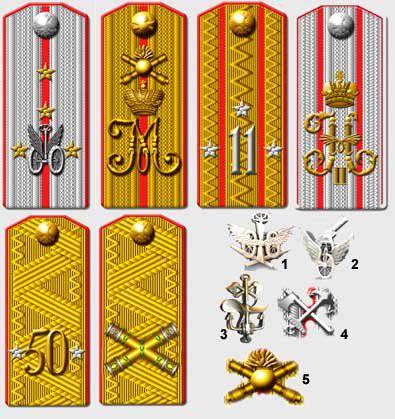 From left to right top row:
From left to right top row:* Headquarters captain of the Automotive Training Company. The special sign of motorists is placed instead of encryption. So it was established by the introduction of insignia for this company.
* Captain of the Caucasian Grand Duke Mikhail Nikolayevich Grenadier Artillery Brigade. Galun, like all golden artillery, is the monogram of the brigade chief gold, as is the special sign of the grenadier artillery. The special sign is placed above the monogram. The general rule was to place special signs above ciphers or monograms. The third and fourth stars were placed above the encryption. And if the officer had special signs, the asterisks are above the special sign.
* Lieutenant Colonel 11 Izyumskogo hussars of the regiment. Two stars, as it should be on the sides of the encryption, and the third over the encryption.
* Out-adjutant. Chin equal to Colonel. Externally from the colonel, he is distinguished by white edging around the field of a regimental regimental color (here it is red). The monogram of Emperor Nicholas II, as befits a wing-adjutant of the color opposite to the color of the galun.
* Major General 50-th division. Most likely, this is the commander of one of the brigades of the division, since the divisional commander wears the corps number (in Roman numerals), which includes the division, on shoulder straps.
* Field Marshal General. The last Russian Field Marshal was D.A. Milyutin, who died in 1912 year. There was, however, in the period of the First World War, another man who had the rank of Field Marshal of the Russian Army - the king of Montenegro Nikolai I Negosh. But it was what is called a "wedding general." He had nothing to do with the Russian Army. The assignment of this title to him was purely political.
* 1-special sign of anti-aircraft artillery auto parts, 2-special sign of anti-aircraft machine-gun machine, 3-special sign of motor-baton battalion, 4-special sign of railway parts, 5-special sign of grenadier artillery.
Letter and digital ciphers (Order of the Ministry of Defense No. 100 1909 and the General Staff Circular No. XXNX-7):
* Encryption in one row is located at a distance 1 / 2 top (22mm.) From the bottom edge of the shoulder strap with the height of letters and numbers 7 / 8 top (39mm.).
* Encryption in two rows is located - the bottom row at a distance 1 / 2 top (22mm.) From the bottom shoulder strap at the height of letters and letters of the bottom row 3 / 8 top (16,7mm.). The top row is separated from the bottom row by the 1 / 8 top tip (5.6mm.). The height of the upper row of letters and numbers 7 / 8 top (39mm.).
The question about softness or hardness is still open. Regulatory requirements do not say anything about this. Obviously, it all depended on the opinion of the officer. In numerous photographs of the late XIX - early XX century, we see officers in both soft and solid shoulder straps.
It is worth noting that the soft epaulet very quickly begins to look rather sloppy. It lies on the contour of the shoulder, i.e. gets bends, kinks. And if we add to this the frequent putting on and taking off the overcoat, then the shredding of the epaulettes is only intensified. In addition, the shoulder strand fabric due to wetting and drying in rainy weather sets (decreases in size), while the tail of the size does not change. The epaulette shrivels. To a considerable extent, smarching and bending of the shoulder strap can be avoided by placing inside a solid substrate. But a solid shoulder strap, especially on his uniform under his overcoat, puts pressure on his shoulder.
It seems that every time, depending on personal preferences and conveniences, the officers themselves decided which pursuit was best for them.
Comment. On the epaulettes in the letter and number codes, there always was a dot after the number and after each combination of letters. And at the same time, the point was not set with monograms.
From the author. From the author. In the merits and demerits of hard and soft epaulettes, the author was convinced on personal experience already with entering the school in 1966. Following the cadet fashion, I inserted plastic plates into my new shoulder straps. The shoulder straps immediately acquired some elegance, which I really liked. They lay exactly and beautifully on their shoulders. But the very first drill session with weapons made me bitterly regret what was done. These solid epaulettes caused such pain to the shoulders that on the same evening I did the reverse procedure, and I didn’t modish for more than all the years of cadet life.
Officer's shoulder straps of the sixties-eighties of the XX century were tough. But they were sewn on the shoulders of uniforms and overcoats, which, due to bortovka and wool, did not change shape. And at the same time they did not press on the officer’s shoulders. So it was achieved that the shoulder straps did not hesitate, but did not cause inconvenience to the officer.
Epaulettes officers hussar regiments
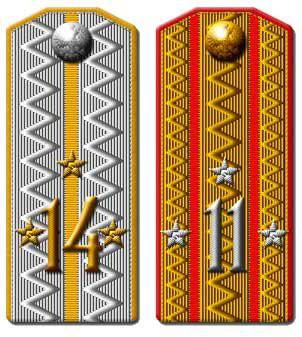 Above we have described epaulettes in their historical development, starting with 1854. However, these epaulets were prescribed for all types of weapons, except for hussar regiments. It is worth recalling that hussar officers, in addition to the well-known dolmans and mantics, had coats, vice uniforms, coats, etc., as in other branches of the military, which differed only in certain decorative elements.
Above we have described epaulettes in their historical development, starting with 1854. However, these epaulets were prescribed for all types of weapons, except for hussar regiments. It is worth recalling that hussar officers, in addition to the well-known dolmans and mantics, had coats, vice uniforms, coats, etc., as in other branches of the military, which differed only in certain decorative elements.The shoulder straps of the hussar officers already 7 in May 1855 of the year received a braid, which had the name "hussar zigzag". The generals, listed on the hussar regiments, did not receive any special galloon. They wore a general-wide galun on uniform.
For the sake of simplicity, we will show only samples of officer hussar episodes of a late period (1913).
To the left is a lieutenant of lieutenant 14 of the Mitavsky hussar regiment, to the right a shoulder strap of lieutenant colonel of the 11 of Izyum hussar regiment. Clearly the location of the stars - the bottom two on the sides of the encryption, the third above. The color of the epaulet field (gaps, edges) have the same color as the epaulet color of the lower ranks of these regiments.
However, the galun "hussar zigzag" had not only officers of hussar regiments on shoulder straps.
Already in 1855, the same tail was assigned to the officers of "His Own Imperial Majesty Convoy" (according to the magazine "Old Tsekhgauz" in March 1856 of the year).
And 29 June 1906, the golden lace of the Hussar zigzag, was received by officers of the Life Guard 4 Infantry Imperial Family Name Battalion. The color of the epaulettes in this battalion is crimson.
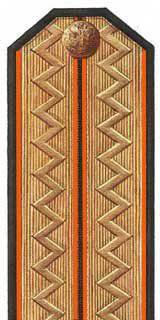 And finally, on 14 on July 1916, the hussar zigzag was assigned to officers of the St. George battalion of the Supreme Headquarters.
And finally, on 14 on July 1916, the hussar zigzag was assigned to officers of the St. George battalion of the Supreme Headquarters.An explanation is required here. This battalion was formed from among the soldiers awarded with St. George's crosses. The officers are all with the Order of St. George 4 Art. Both those and others, as a rule, from among those who, due to injuries, diseases, age, could no longer fight in the ranks.
We can say that this battalion was a kind of repetition of the company of palace grenadiers (created in 1827 from veterans of past wars), only for the front.
The type of shoulder straps of this battalion is also curious. At the lower ranks field epaulet orange with black stripes in the center and along the edges.
The officer’s epaulettes of the battalion were distinguished by the fact that they had a black vypushku, and in the lumen was visible the central thin black stripe. In the picture of this shoulder strap, taken from the description approved by the Minister of War and Infantry General Shuvaev, an orange field, black edging can be seen.
Departing from the topic. Infantry General Shuvaev Dmitry Savelyevich. War Minister from 15 March 1916 to 3 January 1917. By origin of the honorary citizens. Those. not a nobleman, but the son of a man who received only a personal nobility. According to some information, Dmitry Savelyevich was the son of a soldier who rose to junior officer ranks.
Of course, having become a full general, Shuvaev received hereditary nobility.
This is me to the fact that many even top commanders of the Russian Army were not necessarily graphs, princes, landowners, the word "white bone", as Soviet propaganda tried to convince us for many years. And the peasant son could become a general in the same way as the prince. Of course, the commoner needed more effort and effort for this. So in fact, in all other times, the situation was the same today. The sons of big bosses and in Soviet times were much more likely to become generals than the sons of combiners or miners.
And during the Civil War, the aristocrats Ignatiev, Brusilov, Potapov were on the side of the Bolsheviks, while the soldiers' children, Denikin, Kornilov, led the White Movement.
It can be concluded that a person’s political views are determined not by his class origin, but by something else.
The end of the retreat.
Breasted front officers and generals stock and retired
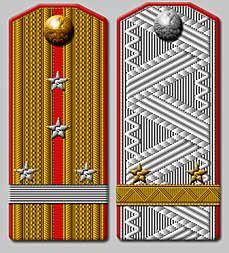 Everything described above applies only to officers on active military service.
Everything described above applies only to officers on active military service. The officers and generals who were in reserve or retirement until 1883 of the year (according to S. Popov) did not have the right to wear epaulettes or epaulets, although they usually had the right to wear military clothing as such.
According to V.Glinka, officers and generals who were dismissed from service “with uniform” did not have the right to wear an epaulet (and with the introduction of epaulets and them) from 1815 to 1896 a year.
Officers and generals in stock.
In the 1883 year (according to S. Popov), generals and officers in the reserve and having the right to wear a military uniform were obliged to wear a cross patch of galun in reverse color 3 / 8 width (17mm.) On shoulder straps.
In the figure to the left of the captain in the reserve, to the right of the major general in the reserve.
Please note that the pattern of the general's badge is somewhat different from the officer's.
I dare to assume that since the officers and generals of the reserve were not listed in certain regiments, they did not carry ciphers and monograms. In any case, according to Schenk’s book, the monograms on epaulets and epaulets are not carried to the reserve-general adjutants, aide-de-camp and major generals of His Majesty, as well as all others who dropped out of the suite for any reason.
Officers and generals dismissed "with uniform" wore epaulets with a special pattern.
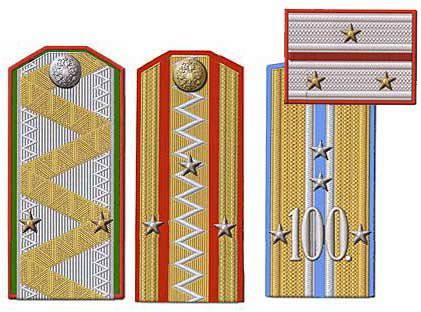 So the general's zigzag on the chase was covered with a strip of 17-mm. galuna of the opposite color, which in turn has a general zigzag pattern.
So the general's zigzag on the chase was covered with a strip of 17-mm. galuna of the opposite color, which in turn has a general zigzag pattern.For retired staff officers, the place of the purply galun was used for the “hussar zigzag”, but with the reverse color zigzag itself.
Comment. The textbook for the rank and file edition of 1916 of the year indicates that the average lace on the pursuit of a retired staff officer was completely the opposite color, not just a zigzag.
Retired ober officers (according to 1916's “Manual for the rank and file”) wore rectangular short shoulder straps located across the shoulder.
A very special lace worn by officers dismissed for injuries and retired officers of the St. George Cavaliers. In their parts the galuna adjoining the gaps had the opposite color.
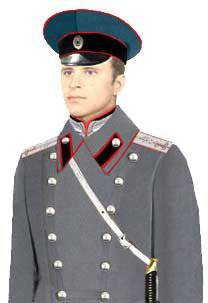 The figure shows the shoulder straps of a retired Major General, a retired lieutenant colonel, a retired lieutenant and a staff captain dismissed for injuries or a St. George cavalier in retirement.
The figure shows the shoulder straps of a retired Major General, a retired lieutenant colonel, a retired lieutenant and a staff captain dismissed for injuries or a St. George cavalier in retirement. By the way, the author does not have confidence that retired officers could wear the encryption of their regiments or monograms, as shown in the figure.
In the picture to the right are shoulder straps on an officer's coat on the eve of the First World War. Here the chief officer of the Grenadier Saperny battalion.
In October, the 1914 of the year (Order of the Order of the Army No. 698 of 31.10.1914) in connection with the outbreak of war for the troops of the Army, i.e. For the units located at the front and the marching units (that is, the units moving to the front), hiking shoulder straps were introduced. I quote:
"1) To generals, headquarters and chief officers, doctors and military officers of the army in accordance with the protective shoulder straps of the lower ranks - to install shoulder straps cloth, protective, without release, with buttons oxidized for all parts, with embroidered dark orange (light brown) stripes (tracks) to indicate rank and with oxidized asterisks to indicate rank ...
3) On overcoats, instead of protective shoulder straps, officers, military officials, and ensigns are allowed to have shoulder straps of greatcoat cloth (where the lower ranks have the same ones).
4) The embroidery of the strips is allowed to be replaced by stripe of narrow ribbons of dark orange or light brown color.
5) Sweet Menzel images on marked shoulder straps have embroidered light brown or dark orange silk, and other encryption and special signs (if they are needed) have oxidized (burned) overhead. ....
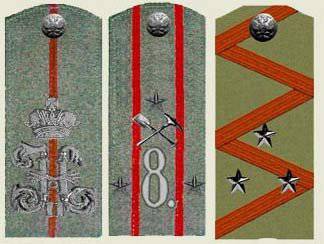 a) stripes to indicate rank should be: the general officers are zigzag, the headquarters officers are double, the chief officers are single, all the width around the 1 / 8 top;
a) stripes to indicate rank should be: the general officers are zigzag, the headquarters officers are double, the chief officers are single, all the width around the 1 / 8 top; b) shoulder straps: for officers - 1 3 / 8 - 1 1 / 2, doctors, and military officials - 1 - 1 1 / 16 ... .... "
Thus, galunnye shoulder straps in 1914, gave up their place on the marching form of simple and cheap hiking epaulettes.
However, for the troops in the rear districts and in both capitals galanous epaulets were preserved. Although, it should be noted that in February 1916, the commander of the Moscow district, general from artillery I.Mrozovsky. issued an order (No. 160 from 10.02.1916), in which he demanded that officers should wear exclusively braun shoulder straps in Moscow and in general throughout the Okrug, and not marching, which are prescribed only for the Army. Obviously, the wearing of hiking epaulettes in the rear at that time became widespread. Everyone apparently wanted to look like experienced front-line soldiers.
At the same time, on the contrary, galunny shoulder straps "come into fashion" in the front parts in 1916 year. This was especially distinguished by the ripening officers graduated from the wartime warrant officers' schools, who were not able to have time to flaunt a beautiful dress uniform and golden shoulder straps in the cities.
When the Bolsheviks came to power in Russia 16 in December, 1917 issued a decree of the Central Executive Committee and the Council of People's Commissars abolishing all ranks and titles and "outdoor differences and titles" in the army.
Galunov epaulets disappeared from the shoulders of Russian officers for a long twenty-five years. In the Red Army, created in February 1918, there was no epaulette until January, 1943.
During the Civil War in the armies of the White Movement there was a complete inconsistency - from wearing epaulets to the destroyed Russian Army, to complete denial of epaulets and in general any signs of distinction. Here everything depended on the opinions of local military leaders, who are quite powerful in their own bounds. Some of them, such as the chieftain Annenkov, generally began to invent their own form and insignia. But this is the topic of individual articles.
Sources and Literature
1. The magazine "Old tsekhgauz" №2-3 (40-41) -2011g.
2. Historical description of clothes and military of Russian troops. Part nineteenth. Issued by the Main Directorate of Quartermaster Directorate. St. Petersburg 1902
3. V.K.Shenk. Rules for wearing clothing by officers in all cases of arms. S.-Petersburg. 1910
4. V.K.Shenk. Tables of uniforms of the Russian Army. S.-Petersburg. 1910
5. V.K.Shenk. Tables of uniforms of the Russian Army. S.-Petersburg. 1911
6. V.V.Zvegintsov. Forms of the Russian Army. Paris.1959g.
7. Poster "Outdoor honors and the title of the military and maritime authorities." 1914
8. MM Khrenov and others. Military clothes of the Russian Army. Military publishing. Moscow. 1994
9. Site "Insignia of the Russian Imperial Army in 1913 year" (semiryak.my1.ru).
10.V. M. Glinka. Russian military suit of the 1988th-early XNUMXth century. Artist of the RSFSR. Leningrad. XNUMX
11. Military Encyclopedia. Tom 7. T.I.D.Sytina. Petersburg.1912g.
12.Phot. A textbook for a soldier in the first year of service. Publication XXVI. Jus.1916g.
Information